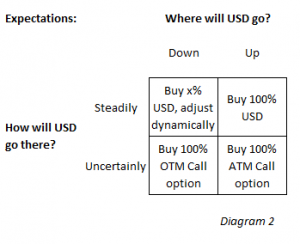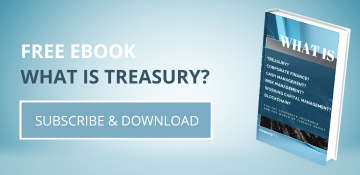Managing Treasury Risk – Foreign Exchange Risk (Part III)
| 7-2-2017 | Lionel Pavey |
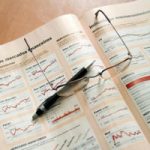
There are lots of discussions concerning risk, but let us start by trying to define what we mean by risk. In my third article I will focus on foreign exchange risk. This risk has to be taken into consideration when a financial commitment is denominated in a currency other than the base currency of a company.
There are 4 types of foreign exchange risk.
Transaction Risk
Transaction risk occurs when future cash flows are denominated in other currencies. This refers to both payables and receivables. Adverse changes in foreign exchange prices can lead to a fall in profit, or even a loss.
Translation Risk
Translation risk occurs when accounting translation for asset and liabilities in financial statements are reported. When consolidating from an operating currency into a reporting currency (overseas offices etc.) the value of assets, liabilities and profits are translated back to the reporting currency. Translation risk does not affect a company’s cash flows, but adverse changes can affect a company’s earnings and value.
Economic Risk
Economic risk occurs when changes in foreign exchange rates can leave a company at a disadvantage in comparison to competitors. This can affect competitive advantage and market share. Future cash flows from investments are also exposed to economic risk.
Contingent Risk
Contingent risk occurs when potential future work is expressed in a foreign currency. An example would be taking part in a tender for work in another country where the pricing is also in a foreign currency. If a company won a large foreign tender, which results in an immediate down payment being received, the value of that money would be subject to transaction risk. There is a timeframe between submitting a tender and knowing if the tender has been won, where a company has contingent exposure.
Identifying Foreign Exchange Risk
- What risk does a company face and how can it be measured
- What hedging or rate management policy should a company use
- What financial product, available in the market, should be best used
- Does the risk relate to operational cash flows or financial cash flows
Initially we need to ascertain what we think future FX rates will be. Methods that can be used include the Forward Rate Parity, the International Fisher Effect which also includes expected inflation, forecasts provider by banks and international forums, along with VaR. Model analysis can be provided, among others, via fundamental factors, technical analysis, and political analysis.
Different FX rates can then be used to simulate the effects on cash transactions when converted back into the base currency. This will provide different results that will allow a company to determine what level of risk it is prepared to accept. Finally a decision must be taken as to whether the company wishes to hedge its exposure or not. Before the advent of the Euro, both the Netherlands and Germany were members of the Exchange Rate Mechanism (ERM). This meant there was agreed band within which the spot rate could move around an agreed central point – this was NLG 112.673 equal to DEM 100.00 with a bandwidth of +- 2.25%. For some companies, this tight band meant that they took the decision not to hedge any exposure between DEM and NLG.
Financial products that are commonly used to manage foreign exchange risk include Forward Exchange contracts, Futures, Caps, Floors, Collars, Options, Currency Swaps and Money Market hedging.

Cash Management and Treasury Specialist
More articles of this series:
Managing treasury risk: Risk management
Managing treasury risk: Interest rate risk



 (1.5%, see diagram 5) by the chance it will be exercised (Delta, in this case 25%), ie 1.5% : 25% = 6%. It could be a very disappointing to find that if this Conditional Premium option is only marginally ITM at maturity, because the premium of 6% still has to be paid.
(1.5%, see diagram 5) by the chance it will be exercised (Delta, in this case 25%), ie 1.5% : 25% = 6%. It could be a very disappointing to find that if this Conditional Premium option is only marginally ITM at maturity, because the premium of 6% still has to be paid.
 bought the option for 1.5%, we could sell it after 3 months at 1.1% and buy the USD through an outright forward transaction. This approach shows that the net cost of option protection would be only 0.4% (1.5% – 1.1%). Which would be cheaper than the premium of a 3-month option with the same Delta. Also, because the option has a higher Delta than a 3-month option with the same strike (25% vs 10%, see diagram 2), it will follow the spot market much better. The bottom line of paragraph 3 is that a longer dated option can be bought with the intention to sell it again at some point, the net cost being less than buying a shorter dated option. While it serves as a hedge against price changes.
bought the option for 1.5%, we could sell it after 3 months at 1.1% and buy the USD through an outright forward transaction. This approach shows that the net cost of option protection would be only 0.4% (1.5% – 1.1%). Which would be cheaper than the premium of a 3-month option with the same Delta. Also, because the option has a higher Delta than a 3-month option with the same strike (25% vs 10%, see diagram 2), it will follow the spot market much better. The bottom line of paragraph 3 is that a longer dated option can be bought with the intention to sell it again at some point, the net cost being less than buying a shorter dated option. While it serves as a hedge against price changes. buy the 1-year option in diagram 2 for 1.5%. Alternatively we could consider buying a right to buy this option for 0.4% in 3 months time. At that time the 1-year option will only have 9 months remaining, but the strike and 1.5% premium are fixed in the contract. On the expiry date of the compound option we can decide if we want to pay 1.5% for the underlying option. Alternatively, assuming nothing has changed, we could buy a 9 month option in the market for 1.1% (see diagram 2). In such a case we wouldn’t exercise the compound option.
buy the 1-year option in diagram 2 for 1.5%. Alternatively we could consider buying a right to buy this option for 0.4% in 3 months time. At that time the 1-year option will only have 9 months remaining, but the strike and 1.5% premium are fixed in the contract. On the expiry date of the compound option we can decide if we want to pay 1.5% for the underlying option. Alternatively, assuming nothing has changed, we could buy a 9 month option in the market for 1.1% (see diagram 2). In such a case we wouldn’t exercise the compound option.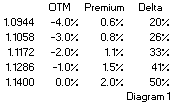 Should we need to exercise the option to get our USD, it still means a combined hedging cost of 3.8%. Which is more than if we had bought the ATM option for 2% premium. Conclusion: Buying an OTM option reduces the up-front cost versus buying an ATM option. But ex-post hedging with an OTM option could result in total hedging cost which are higher than an ATM option.
Should we need to exercise the option to get our USD, it still means a combined hedging cost of 3.8%. Which is more than if we had bought the ATM option for 2% premium. Conclusion: Buying an OTM option reduces the up-front cost versus buying an ATM option. But ex-post hedging with an OTM option could result in total hedging cost which are higher than an ATM option.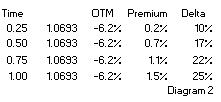 option is exercised, or the USD must be purchased from the market at the prevailing rate.
option is exercised, or the USD must be purchased from the market at the prevailing rate.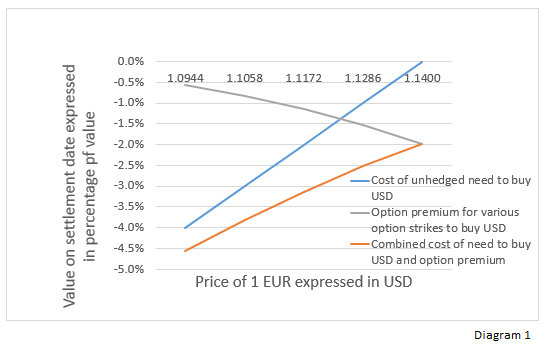
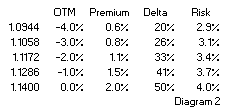 Risk appears fairly stabile across strikes, which makes sense because the premiums are calculated with one volatility on one underlying. The Risk on OTM is lower than that for ATM options. It appears that OTM premiums are relatively more expensive, they give protection against less potential loss.
Risk appears fairly stabile across strikes, which makes sense because the premiums are calculated with one volatility on one underlying. The Risk on OTM is lower than that for ATM options. It appears that OTM premiums are relatively more expensive, they give protection against less potential loss.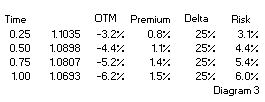 Diagram 3 shows Premiums, Delta and Risk for different tenors. ‘Time’ is the time to expiry of the options in fractions of years. Its shows that for longer tenors, the Risk is higher. But disproportionally. For the same chance on exercise a hedger could double the premium to buy a hedge for a 4x longer tenor.
Diagram 3 shows Premiums, Delta and Risk for different tenors. ‘Time’ is the time to expiry of the options in fractions of years. Its shows that for longer tenors, the Risk is higher. But disproportionally. For the same chance on exercise a hedger could double the premium to buy a hedge for a 4x longer tenor.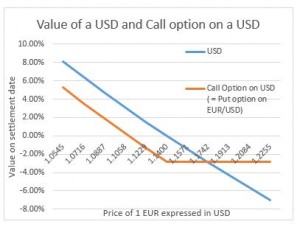 Diagram 1 explains his feelings. I assume he was considering only the left half of the payoff diagram. After an appreciation of the USD, a USD is always worth more than a call option on a USD, the difference being the option premium.
Diagram 1 explains his feelings. I assume he was considering only the left half of the payoff diagram. After an appreciation of the USD, a USD is always worth more than a call option on a USD, the difference being the option premium.